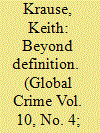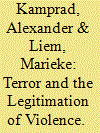|
|
|
Sort Order |
|
|
|
Items / Page
|
|
|
|
|
|
|
| Srl | Item |
| 1 |
ID:
166673


|
|
|
|
|
| Summary/Abstract |
While the number of American jihadi terrorist attacks remains relatively rare, terrorist plots thwarted by law enforcement have increased since September 11, 2001. Although these law enforcement blocks of would-be terrorists are considered counterterrorism triumphs by the FBI, human rights and civil liberty watch groups have conversely suggested that those who plan for attacks alongside government informants and undercover agents may be unique and essentially dissimilar from terrorists. Underlying this debate is the empirical question of how planned yet unsuccessful attacks and their plotters compare to successful terrorist homicides and their perpetrators. The current study addresses this question by comparatively examining jihadi terrorist homicides and unsuccessful plots occurring in part or wholly on U.S. soil between 1990 and 2014. Data for this study come from the U.S. Extremist Crime Database (ECDB), an open-source database with information on terrorism and extremist crimes. Based on these data, descriptive statistics are provided for several incident, offender, and target variables across three jihadi terrorist violence categories, including homicides, plots with specified targets, and plots with non-specific targets. We find several important differences across categories of terrorist violence, suggesting that unsuccessful plotters and their intended crimes vary from their more successful terrorist counterparts.
|
|
|
|
|
|
|
|
|
|
|
|
|
|
|
|
| 2 |
ID:
092121


|
|
|
|
|
| Publication |
2009.
|
| Summary/Abstract |
While conceptualising violence - in either minimalist or comprehensive understandings - has posed significant problems for scholars, the problem of measuring or quantifying it has been equally challenging for both researchers and policy makers. This article examines the best available current evidence on the 'global burden of armed violence' and highlights what we know and do not know about the scope, scale, and distribution of different forms of violence worldwide, especially what policy makers have called 'armed violence' (the minimalist conception). It also examines the definitional and conceptual constraints that challenge any attempt to develop cross-national and cross-cultural comparisons, and the limitations of existing data, and brings the empirical evidence to bear on the conceptual debates that animate this volume. Finally, it raises some questions concerning the way in which the different forms that violence takes may (or may not) be linked, and the issues this raises for future 'global' comparisons.
|
|
|
|
|
|
|
|
|
|
|
|
|
|
|
|
| 3 |
ID:
184236


|
|
|
|
|
| Summary/Abstract |
We investigate persistence and determinants of deaths from conflicts in a sample of 163 countries for the period 2010–2015. The empirical evidence is based on the Generalized Method of Moments. First, the findings are contingent on income levels, religious domination, landlockedness, regional proximity, and legal origins. We find that the persistence of deaths in internal conflict is more apparent in coastal, French civil law, and Islam-oriented countries, compared to landlocked, English common law, Christian-oriented countries, respectively. Second, the following factors are generally responsible for driving deaths from internal conflicts: homicides, conflict intensity, and conflicts fought. Furthermore, incarcerations have negative effects on internal conflicts. Justifications for the established tendencies and policy implications are discussed.
|
|
|
|
|
|
|
|
|
|
|
|
|
|
|
|
| 4 |
ID:
182668


|
|
|
|
|
| Summary/Abstract |
This article posits that free-market institutions and practices reduce economic distortions that provide rents for underground organizations, which ultimately form criminogenic environments. Rents from market distortions provide ‘lootable income’ that feeds ‘criminal organizations’, which rely on violence for enforcement of contracts. Using an index of economic freedom, this study contrasts several relevant measures of political freedoms, political discrimination of individuals and groups, and measures of equal access to state ‘goods’ as proxies for political legitimacy and discrimination on the homicide rate. Fixed effects regression results suggest robustly that economic freedom, not political legitimacy, inclusive politics, or state capacity, reduces the homicide rate, results that are stubbornly significant and substantively large. The basic results are robust to a barrage of model specifications, different sample sizes, and estimation strategies, including instrumental variables analysis. The evidence suggests that unusually high homicide rates might be based in quotidian organizational activities related to ‘illegal’ markets rather than to political grievance-based explanations relating to relative deprivation and political legitimacy. Countries wishing to encourage growth-promoting policies need not fear higher levels of interpersonal violence based on various arguments linking free-market policies to societal disarray.
|
|
|
|
|
|
|
|
|
|
|
|
|
|
|
|
| 5 |
ID:
159798


|
|
|
|
|
| Summary/Abstract |
Studies undertaken on female homicide offenders are limited in both number and breadth, particularly within South East Asia. This article has consequently chosen to explore Cambodian women’s narratives of their journeys to prison for homicide offending using a feminist pathway approach. Results show a number of common threads in the women’s stories: childhood instability, economic marginalisation, criminalisation occurring within the milieu of a relationship with a man and limited access to justice and/or ability to benefit from corrupted criminal justice practices. Additionally, six distinct pathways were identified from the narratives: 1) domestic violence pathway, 2) pathway of marital abandonment, 3) traumatic life history pathway, 4) deviant women pathway, 5) pathway of male association, 6) pathway of feminine familial sacrifice.
|
|
|
|
|
|
|
|
|
|
|
|
|
|
|
|
| 6 |
ID:
113938


|
|
|
|
|
| Publication |
2012.
|
| Summary/Abstract |
Why are some countries more prone to social violence than others? Despite the fact that annual deaths due to homicides worldwide outnumber those due to organized armed conflict by a factor of roughly 3 to 1, this question has received very little attention from conflict and development specialists in recent years. As a modest first step in addressing this gap in the literature we draw together insights from the conflict and criminology literatures to develop a model of social violence that accounts for both political-institutional and socio-economic factors. While there is an extensive literature on the socio-economic determinants of social violence, there are only a handful of studies that consider the significance of political-institutional arrangements. Using cross-country estimates of homicides produced by the World Health Organization as an indicator of social violence, we test our model using OLS regression analysis for a sample of more than 120 countries. We find that countries with 'hybrid' political orders experience higher rates of social violence than those with strong autocratic or strong democratic regimes, and that weakly institutionalized democracies are particularly violent. We also find robust associations between indicators of poverty, inequality and ethnic diversity and social violence. These results indicate that social and political violence share some common underlying causes. We conclude by suggesting that the apparent global decline in organized armed conflict and the concomitant rise in social violence in recent decades may be linked to world urbanization and the 'third wave' of democratization in the global South, although further research is required to confirm this hypothesis.
|
|
|
|
|
|
|
|
|
|
|
|
|
|
|
|
| 7 |
ID:
173140


|
|
|
|
|
| Summary/Abstract |
Some theories predict that profits facilitate peace in illegal markets, while others predict that profits fuel violence. I provide empirical evidence from drug trafficking in Venezuela. Using original data, I compare lethal violence trends in municipalities near a major trafficking route to trends elsewhere, both before and after counternarcotics policy in neighboring Colombia increased the use of Venezuelan transport routes. For thirty years prior to this policy change, lethal violence trends were similar; afterward, outcomes diverged: violence increased more along the trafficking route than elsewhere. Together with qualitative accounts, these findings illuminate the conditions under which profits fuel violence in illegal markets.
|
|
|
|
|
|
|
|
|
|
|
|
|
|
|
|
| 8 |
ID:
178905


|
|
|
|
|
| Summary/Abstract |
This study investigates the relationship between terrorism and interpersonal violence by conducting cross-national analyses on the effects of terrorism mortality rates on homicide rates. Results show that terrorism appears to be robustly and positively associated with homicide. This finding is based on the calculation of a series of independently pooled and twoways fixed-effects models on a panel that incorporates more than 165 countries over 24 years (1991–2014). The results lend tentative support to the so-called “legitimation-habituation” hypothesis that was formulated in regard to the effects of security-related stress on homicide rates in Israel more than 30 years ago. The topic has been largely neglected ever since. While confirming a positive relationship between terrorism and homicide, this study concludes that a causal influence of terrorism on homicide rates is conceivable, but cannot conclusively be proven within the confines of the research design. Future research on potential mediators of the supposed effect is needed, and data limitations need to be overcome.
|
|
|
|
|
|
|
|
|
|
|
|
|
|
|
|
| 9 |
ID:
161126


|
|
|
|
|
| Summary/Abstract |
This article focuses on the systemic failures of the Nigerian police force to unravel the mysteries surrounding homicides in the country, along with the security, social and political implications of the ongoing trend. The article draws on documented pieces of evidence of high-profile murders, along with the causes of the upsurge in murder incidences and the inhibitive factors relating to the investigative procedures of the police. The suitability of the theory of subaltern realism and the concept of third-world security predicaments in explaining the peculiarities of Nigeria’s internal security challenges is examined, along with the problems of the legitimacy of political regimes and weak borders. There is a need for the National Assembly of Nigeria to exercise its constituted powers in reawakening and supervising investigations into dormant cases of murder through its committees on police affairs, public safety and national security. The police should check its organisational failures, which may be related to using the wrong investigative approaches, low levels of information, limited resources, corrupt practices, and pressure to obtain quick results.
|
|
|
|
|
|
|
|
|
|
|
|
|
|
|
|
|
|
|
|
|